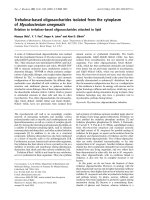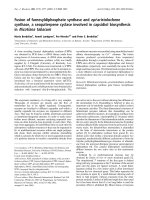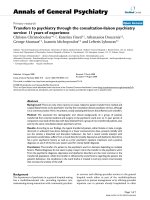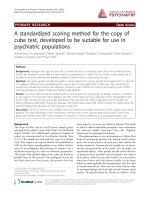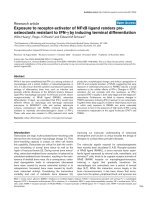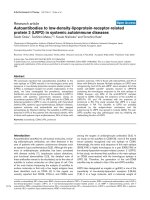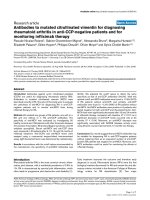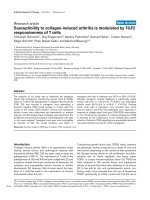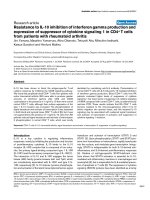Báo cáo y học: " Fusion to chicken C3d enhances the immunogenicity of the M2 protein of avian influenza virus" potx
Bạn đang xem bản rút gọn của tài liệu. Xem và tải ngay bản đầy đủ của tài liệu tại đây (725.77 KB, 11 trang )
Zhang et al. Virology Journal 2010, 7:89
/>Open Access
RESEARCH
© 2010 Zhang et al; licensee BioMed Central Ltd. This is an Open Access article distributed under the terms of the Creative Commons
Attribution License ( which permits unrestricted use, distribution, and reproduction in
any medium, provided the original work is properly cited.
Research
Fusion to chicken C3d enhances the
immunogenicity of the M2 protein of avian
influenza virus
Zhenhua Zhang
1,2
, Yongqing Li*
†2
, Shufang Xu
2
, Fuyong Chen*
†1
, Li Zhang
2
, Beiyu Jiang
2
and Xiaoling Chen
2
Abstract
Background: Current vaccines to avian influenzae virus (AIV), a highly contagious disease of birds, need to be
constantly updated due to the high level of variation in the target antigens. Therefore, a vaccine that could induce
broad cross protection against AIV is required. The M2 membrane protein is structurally conserved amongst AIV
subtypes but tends in induce a poor immune response, whereas C3d has been shown in many species to enhance
immunogenicity. In this study, we investigated the potential of M2-avian C3d fusion proteins to provide effective
immunity.
Results: We fused chicken complement C3d to sM2 (M2 protein with the transmembrane region deleted) of AIV and
expressed four fusion proteins, GST (Glutathione S-transferase tagged proteins in pGEX expression vector) -C3d-sM2,
GST-C3d-L2-sM2, GST-C3d-L1-C3d-sM2 and GST-C3d-L1-C3d-L2-sM2 were used to immunize mice. In addition, Specific
pathogen free (SPF) chickens were inoculated with the plasmids pcDNA-sM2, pcDNA-C3d-L1-C3d-L2-sM2, GST-sM2
and GST-C3d-L1-C3d-L2-sM2. The immune response was monitored by an enzyme-linked immunosorbent assay
(ELISA) for sM2 antibody, and all the test animals were challenged with A/chicken/Bei Jing/WD9/98 (H9N2) virus.
Results revealed that the anti-sM2 antibody in mice and chickens vaccinated with these proteins was higher than the
nonfused forms of sM2, the GST-C3d-L1-C3d-L2-sM2 groups have conferred the highest 30% and 20% protection ratio
in mice and chickens respectively. In addition, the pcDNA-C3d-L1-C3d-L2-sM2 also enhances the antibody responses
to sM2 compared to pcDNA-sM2 in chickens, and acquired 13.3% protection ratio.
Conclusion: These results indicated that chicken C3d enhanced the humoral immunity against AIV M2 protein either
fused proteins expressed by the prokaryotic system or with the DNA vaccine. Nevertheless, in view of the poor
protection ratio for these animals, we speculated that this is not a worthy developing of vaccine in these constructs.
Background
Complement is a protein system in the plasma of humans
and animals [1]. After being activated, a series of impor-
tant biological reactions generate several complement
proteins that nonspecifically defend against invading
pathogens [2]. While complement protein C3 is a central
component of the innate immune system, it also plays an
important role in stimulating the humoral immune
response [1,3]. At the point of convergence of three dis-
tinct pathways of complement activation, C3 is cleaved
into C3a and C3b by the C3 convertase [4]. Further prote-
olytic cleavage of C3b results in the formation of C3c and
C3dg. The C3dg product can be further degraded by a
variety of cellular proteases into C3d, a protein which
attaches covalently to the surface of pathogens and
upregulates B-cell responses [4,5]. Previous studies have
demonstrated that C3d could enhance antigen recogni-
tion and specific immunoglobulin synthesis by antigen-
specific B cells, as the antigen is taken up and processed
via cell receptor 2 (CR2) by both antigen-specific and
non-specific B cells [6]. Subsequent investigations
showed that three copies of murine C3d could dramati-
cally enhance antibody responses to specific antigen,
being 100-fold more effective than incomplete Freund's
* Correspondence: ,
2
Institute of Animal Husbandry and Veterinary Medicine, Beijing Academy of
Agricultural and Forestry Sciences, Beijing 100097, China
1
College of Animal Medicine, China Agricultural University, Beijing 100094,
China
†
Contributed equally
Full list of author information is available at the end of the article
Zhang et al. Virology Journal 2010, 7:89
/>Page 2 of 11
adjuvant [7,8]. Ross reported that C3d could enhance
antibody responses directed toward a specific antigen
encoded by a DNA vaccine [9]. A DNA vaccine express-
ing a fusion of hemagglutinin (HA) from influenza virus
or measles virus fused to three copies of the murine
homologue of C3d (mC3d) achieved an early and efficient
immune response in mice. Fusion to C3d has been shown
to increase the immunogenicity of the capsular polysac-
charide antigen of Streptococcus pneumoniae [10]. Using
DNA vaccination, various forms of envelope (Env) pro-
teins of the human immunodeficiency virus type 1 (HIV-
1) fused at the carboxyl terminus with C3d of murine
complement, generated high-titer, long-lasting, neutraliz-
ing antibodies in mice [11]. In addition, the human
homologue of C3d (hC3d) also enhanced anti-Env anti-
bodies in rabbits when it was fused to sgp120 [12].
Recently, Wang reported that the bovine homologue of
C3d (boC3d) coupled to the E2 envelope protein of
bovine viral diarrhea virus greatly enhanced immunoge-
nicity in mice [13]. Liu also reported that chicken C3d-
P29 linked to the F gene of Newcastle disease virus
(NDV) enhanced immunogenicity in chickens [14].
Logan GJ found C3d (3)-fusion markedly increase anti-
body responses to the AAV-encoded model antigen (hen
egg lysozyme) with greater than 50-fold enhancement in
responses [15]. Comparison of the human, mouse and
bovine C3d sequences showed 84.1% amino acid homol-
ogy between hC3d and mC3d and 80.5% homology
between hC3d and boC3d, they either showed the func-
tion of immune adjuvant in mammalian model. Informa-
tion on the function of avian C3d is scarce. Importantly,
there are structural differences in the mammalian and
avian immune systems, particularly the role of the bursa
as one of the central immune organs in avian species.
Avian influenza (AI), caused by avian influenza virus
(AIV), is a highly contagious disease of birds. Current AI
vaccines induce antibodies against HA and neuramini-
dase (NA), two major surface glycoproteins expressed on
the virus particles. However, due to rapid antigenic varia-
tion of HA and NA, AI vaccine can not protect avian
against the new avian influenza virus strains. A vaccine
that is less sensitive to the antigenic evolution of the virus
would be a major improvement. As a result, vaccines have
to be updated continuously to prevent disease emerging
due to new viral strains. Hence, a vaccine that could
induce broad cross protection against AIV would be
desirable.
The Matrix protein 2 (M2) is an integral tetrameric
membrane protein of AIV. Natural M2 protein is present
in a few copies in the virus particle but in abundance on
virus-infected cells. In contrast to hemagglutinin and
neuraminidase, M2 is almost nonimmunogenic, and its
sequence is highly conserved in all diverse subtypes of
AIV. Several investigations have shown that the M2 pro-
tein has the potential to induce a broadly protective
immunity against AIV. M2-specific antibodies have been
shown to restrict virus growth in vitro and in vivo and
thus have the potential of providing cross-reactive resis-
tance to influenza type A virus infection [16]. Frace
reported that vaccination with the protein M2 was found
to raise M2-specific serum antibodies and enhance viral
clearance in mice challenged with homologous and heter-
ologous influenza A viruses [17]. Neirynck reported that
the M2 domain was genetically fused to the hepatitis B
virus core (HBc) protein to create fusion gene coding for
M2HBc, and intraperitoneal or intranasal administration
of purified M2HBc particles to mice provided 90-100%
protection against a lethal virus challenge [18]. Zhao
designed a tetra-branched multiple antigenic peptide
(MAP)-based vaccine, designated M2e-MAP, which con-
tains the sequence overlapping the highly conserved
extracellular domain of matrix protein 2 (M2e) of a HPAI
H5N1 virus, animals test results showed that M2e-MAP
vaccine induced strong M2e-specific IgG antibody
responses following 3-dose immunization of mice with
M2e-MAP in the presence of Freunds' or aluminium
(alum) adjuvant [19]. Rao SS have shown that vaccination
with M2 in recombinant DNA and/or adenovirus vectors
or with adjuvants confers protection against lethal chal-
lenge in the absence of HA, and also find that the protec-
tive efficacy of NP and M2 diminishes as the virulence
and dose of the challenge virus are increased [20]. How-
ever, M2 is only a minor protein component of AIV, and
tends to induce a poor immune response [21]. To over-
come the shortcomings of M2-based vaccines, in this
study we investigated the potential of M2-avian C3d
fusion proteins to provide effective immunity.
Results
Cloning and sequence analysis of the chicken C3d gene
fragment
Chicken C3d has not previously been cloned so it was
necessary to clone and sequence the complement C3d
fragment. A PCR product of approximately 1 kb was
amplified from RNA extracted from chicken liver tissue.
The fragment was cloned into the pMD18-T (Takara)
plasmid and sequenced. Sequence analysis revealed that
the amplified fragment was 993 bp in length and that the
chicken C3d gene was 897 bp in length. This nucleotide
sequence for chicken C3d was submitted to the GenBank
database (DQ291160). The chicken C3d sequence
showed the following % identities to the published
sequences for C3d from: Arbor Acres chicken (EF632299)
99.8%; human (NM_000064) 66.4%; mouse (BC043338)
66.2%; hamster (AB024425) 67.9%; cow (AY630404)
67.2%; rabbit (M32434) 67.0%; pig (NM_214009) 66.8%;
chimpanzee (XM_512318) 66.4% and sheep (AF038130)
66.9%, as determined by Clustal W multiple alignment of
Zhang et al. Virology Journal 2010, 7:89
/>Page 3 of 11
nucleotide sequences. The predicted protein sequence of
chicken C3d showed the following % similarity to the
published protein sequences for C3d from: Arbor Acres
chicken, 100%; human, 61.5%; mouse, 61.9%; hamster,
61.2%; cow, 62.2%; rabbit, 56.5%; pig, 61.9%; chimpanzee,
61.5% and sheep, 61.5%, as determined by DNAStar
ClustalW analysis. A phylogenetic tree of the C3d amino
acid sequences is shown in Fig. 1.
Construction and identification of the recombinant
expression plasmids
Recombinant expression plasmids pGEX-C3d-sM2,
pGEX-C3d-L1-C3d-sM2, pGEX-C3d-L2-sM2, pGEX-
C3d-L1-C3d-L2-sM2 and pcDNA-sM2, pcDNA-C3d-L1-
C3d-L2-sM2 were constructed with gene expression cas-
settes, pGEX-5x-1 and pcDNA4.0-LacZ. EcoRI and XhoI
restriction endonuclease digestion resulted in a linearized
pGEX-5x-1plasmid (of about 4900 bp), expression cas-
settes DNA of two copies of cC3d and sM2 (of about 2100
bp) and gene cassettes DNA of one copy of cC3d and sM2
(of about 1200 bp).
Expression and purification of fusion proteins
E. coli BL21 (DE3) cells were transformed with the four
prokaryotic expression plasmids detailed above. Cells
were then induced by IPTG at 28°C. The expression
products were purified using the SKL method. Examina-
tion by 12% SDS-PAGE showed that the molecular
weight of the single fused copy of cC3d was about 70 kDa,
while the molecular weight of the two copies fused to
cC3d was about 102 kDa, both of these sizes correspond-
ing to the sizes expected (Fig. 2).
SDS-PAGE and Western immunoblot detection of fusion
proteins
Western blot analysis was performed with purified GST-
C3d-L1-C3d-L2-sM2, GST-C3d-L1-C3d-sM2, GST-C3d-
L1-sM2 and GST-C3d-sM2 proteins and the anti-sM2
monoclonal antibody, which had been prepared in our
laboratory. The band of interest was evident on Western
blot analysis, indicating that the recombinant protein had
maintained the antigenicity of the sM2 component (Fig.
3).
Expression of recombinant eukaryotic plasmids in BHK-21
cells
The constructed eukaryotic expression vectors pcDNA-
sM2, pcDNA-C3d-L1-C3d-L2-sM2 and pcDNA4.0 were
transfected into BHK-21 cells. The indirect immunofluo-
Figure 1 Phylogenetic tree of the C3d amino acid sequences from chicken and other species. The phylogenetic tree was generated by neigh-
bour-joining analysis with Clustal W, using DNAStar.
Figure 2 SDS-PAGE analysis of proteins expressed by the expres-
sion vectors containing one or two copies of C3d fused to sM2 in
E. coli, before and after induction. M: protein marker; lane 1: pGEX-
C3d-L2-sM2 before induction; lane 2: pGEX-C3d-L2-sM2 after induc-
tion; lane 3: pGEX-C3d-sM2 before induction; lane 4: pGEX-C3d-sM2 af-
ter induction; lane 5: pGEX-C3d-L1-C3d-sM2 before induction; lane 6:
pGEX-C3d-L1-C3d-sM2 after induction; lane 7: pGEX-C3d-L1-C3d-L2-
sM2 before induction; lane 8: pGEX-C3d-L1-C3d-L2-sM2 after induc-
tion.
Zhang et al. Virology Journal 2010, 7:89
/>Page 4 of 11
rescence test demonstrated that the sM2 protein was
expressed in BHK-21 cells after the cells had been trans-
fected with the pcDNA-sM2 and pcDNA-C3d-L1-C3d-
L2-sM2 eukaryotic expression plasmids (Fig. 4).
Chicken C3d increases the antibody titers of sM2 in BALB/c
mice and protection against challenge
BALB/c mice were immunized three times with purified
GST-C3d-L1-C3d-L2-sM2, GST-C3d-L1-C3d-sM2,
GST-C3d-L1-sM2, GST-C3d-sM2, GST-sM2 proteins
and GST-sM2 mixed in IFA. The results showed that no
anti-sM2 antibody was produced after the first and sec-
ond immunizations with GST-C3d-L1-C3d-sM2, GST-
C3d-L1-sM2 and GST-C3d-sM2 (Fig. 5). After the third
immunization, high level sM2 antibody titers appeared in
six immunized groups. The difference between the GST-
C3d-sM2, GST-C3d-L1-C3d-L2-sM2, GST-sM2 mixed in
IFA immunized groups and the control group (which was
GST-sM2) was very significant (P < 0.01), the anti-sM2
antibody in mice primed with GST-C3d-L1-C3d-L2-sM2
was greater than that in GST-sM2 mixed in IFA group,
but the difference between the two groups was not signif-
icant (P > 0.05). The GST-sM2+IFA and GST-C3d-L1-
C3d-L2-sM2 groups have conferred the highest 30% pro-
tection ratio in mice (Table 1), the GST-C3d-sM2 group
provide 20% protection ratio secondly. Most of mice that
attacked with H9N2 virus have showed some clinical
signs after post-challenge, such as depressed, shiver and
so on.
Chicken C3d enhances the antibody titers of sM2 in SPF
chickens and protection against challenge
SPF chickens were immunized three times with GST-
C3d-L1-C3d-L2-sM2, GST-sM2, GST-sM2 mixed in IFA
and DNA vaccines of pcDNA-sM2 and pcDNA-C3d-L1-
C3d-L2-sM2. In the indirect ELISA, for the fusion pro-
tein groups, the difference between GST-C3d-L1-C3d-
L2-sM2, GST-sM2 mixed in IFA and GST-sM2 (control
group) was very significant (P < 0.01) after the second
immunization. Indeed, the antibody titer of the GST-
C3d-L1-C3d-L2-sM2 immunized group was higher than
that of all the other groups at this point. The difference
between GST-C3d-L1-C3d-L2-sM2 and GST-sM2 mixed
in IFA group was not significant (P > 0.05) after the sec-
ond or third immunization. After the third immuniza-
tion, the difference between the experimental pcDNA-
C3d-L1-C3d-L2-sM2 group and the control pcDNA-sM2
group became significant (P < 0.05) (Fig. 6). The GST-
sM2+IFA group has the highest antibody titer and a
26.7% protection ratio (Table 2), the GST-C3d-L1-C3d-
L2-sM2 and pcDNA-C3d-L1-C3d-L2-sM2 groups pro-
vide 20%, 13.3% protection ratio respectively. No chicken
that received H9N2 virus have showed obvious clinical
signs on 5 days post challenge.
Lymphocyte transformation assay (MTT method) of SPF
chickens
After the third immunization, peripheral blood lympho-
cytes were isolated from the SPF chickens and used in the
lymphocyte transformation assay (see Table 3). Statistical
analysis of the OD
570
values showed that with respect to
LPS-stimulated lymphocytes, the difference in OD values
between the group immunized with GST-C3d1-L1-C3d2-
L2-sM2 fusion protein and control group immunized
with GST-sM2 was very significant (P < 0.01). The differ-
ence between the group immunized with pcDNA-C3d-
L1-C3d-L2-sM2 plasmid and the control group immu-
nized with pcDNA-sM2 was also very significant (P <
Figure 4 Expression in BHK-21 cells of pcDNA-sM2 and pcDNA-
C3d-L1-C3d-L2-sM2 as detected by IFA. (a) Transfection of pcDNA
(200×); (b) Transfection of pcDNA-sM2 (200×); (c) Transfection of pcD-
NA-C3d-L1-C3d-L2-sM2 (200×).
Figure 3 Western-blot analysis of the recombinant proteins GST-
C3d-L1-C3d-L2-sM2, GST-C3d-L1-C3d-sM2, GST-C3d-L1-sM2 and
GST-C3d-sM2. M: protein marker; lane 1: GST-C3d-L1-C3d-sM; lane 2:
GST-C3d-L1-C3d-L2-sM2; lane 3: GST-C3d-sM2; lane 4: GST-C3d-L1-
sM2.
Zhang et al. Virology Journal 2010, 7:89
/>Page 5 of 11
0.01). The lymphocytes in each group stimulated with
Con A showed no significant differences.
Discussion
Many researchers have confirmed that in the immune
system of mammals, complement component C3d as a
molecular adjuvant bridging innate and acquired immu-
nity [7,22,23]. Apart from enhancing the activation of B
cells, promoting the affinity maturity of antibodies and
maintaining immunologic memory, C3d also has the
molecular adjuvant function of enhancing the antigen
presentation of B cells as well as decreasing the activation
threshold of these cells [24-26]. As a molecular adjuvant,
C3d can be linked to different antigens, effectively
enhancing the titer and life-span of specific antibodies
against these antigens [7,27-29]. However, there have
been few reports about the structure and function of
chicken C3d published to date. In 2005, we cloned the
full-length chicken C3d gene and submitted its sequence
to the GenBank database (Accession number:
DQ291160). Amino acid homology between chicken C3d
and mammal C3d was found to be low.
In this study, we fused one to two copies of C3d to the 5'
end of sM2 gene of AIV to construct expression plasmids,
from which fusion proteins were expressed and purified.
We immunized BALB/c mice and SPF chickens with the
purified proteins. The experimental results in mice and
chickens showed that C3d could enhance the antibody
titer to sM2 protein in both host species. In studies using
human and mouse C3d, most researchers considered that
at least three copies of C3d fused to antigen were needed
to enhance immunity [30-32]. Suradhat also reported that
two copies of mouse C3d fused to bovine rotavirus (BRV)
VP7 or bovine herpesvirus type I (BHV-I) glycoprotein D
did not enhance antibody titers to either antigen [33].
Bower reported that there was no relationship between
the copy numbers of C3d binding to antigen and the anti-
body titer [34]. In our present study, no obvious changes
in antibody levels were detected in each C3d injected
group after the first and second immunizations, so
repeated immunizations were performed to improve the
immune response. However, after the third immuniza-
tion, both one copy and two copies of C3d significantly
enhanced the antibody titer against sM2. This indicates
that repeated immunization with chicken C3d can
enhance the humoral immune response to an antigen
molecule. The antibody titers of sM2 produced by immu-
nizing the fusion proteins of two copies of C3d and sM2
bound by two simple amino acid flexible peptides, are sig-
nificantly higher than for other treatment groups. This
result was further verified by immunization of SPF chick-
ens, and agreed with the findings of a previous report
[35]. It is not clear why in mice immunized with fusion
Table 1: Results of protection from immunized mice after challenge.
Groups Vaccine Number of positive/total Protection ratio (%)
1GST-sM2 10/100
2 GST-C3d-sM2 8/10 20
3 GST-C3d-L1-sM2 9/10 10
4 GST-C3d-L1-C3d-sM2 9/10 10
5 GST-C3d-L1-C3d-L2-sM2 7/10 30
6 GST-sM2+IFA 7/10 30
Mice were immunized thrice with GST-sM2, GST-C3d-sM2, GST-C3d-L1-sM2, GST-C3d-L1-C3d-sM2, GST-C3d-L1-C3d-L2-sM2 and GST-
sM2+IFA, respectively. Then all the mice were challenged with 10
6.5
EID
50
of the A/chicken/Bei Jing/WD9/98 (H9N2) virus. On the indicated
days, mice were euthanatized, lung samples were collected and subsequently homogenized and inoculated in SPF chicken embryos for the
presence of infectious virus. Virus isolation was operated as described in the Materials and Methods. The mouse was considered to be
protected whichever HA test was negative in two virus isolations. The protections from immunized mice on day 5 p.i. are shown.
Figure 5 Titers of antibody against sM2 in BALB/c mouse serum
detected by ELISA. Sixty BALB/c mice aged 6 weeks were divided into
6 (n = 10) groups. The mice in the six test groups were immunized
thrice with GST-sM2, GST-C3d-sM2, GST-C3d-L1-sM2, GST-C3d-L1-
C3d-sM2, GST-C3d-L1-C3d-L2-sM2 and GST-sM2+IFA, respectively.
Blood samples were collected before each vaccination and two weeks
after the final booster, and antibody against sM2 were detected by ELI-
SA. Ab-positive cut-off values were set as mean + 2 SD of non-immu-
nized sera. An ELISA Ab titer was expressed as the highest serum
dilution giving a positive reaction. The titer values were showed in 100
(Log2X ± S).
7L PHV
᧤/RJ;s 6᧥
*67 V 0
*67 &G V0
*67&G/V0
*67&G/&GV0
*67 &G / &G / V0
*67
V0
,)$
Zhang et al. Virology Journal 2010, 7:89
/>Page 6 of 11
proteins bearing one copy of C3d or with fusion proteins
that consisted of two copies of C3d only linked with one
flexible peptide, anti-sM2 antibody could not be detected
after two immunizations. It is possible that, because the
molecular weight of C3d is greater than that of sM2, the
C3d stereochemistry blocked sM2 binding. In contrast,
with the protein GST-C3d-L1-C3d-L2-sM2, which has
two flexible peptides, repeated immunizations are not
required, a finding that has been reported previously [34-
36].
Many previous researches have shown the molecular
adjuvant effect of C3d in the immunization of DNA vac-
cines [33,36-39]. However, our immunological test in SPF
chickens found that C3d can enhance the immunogenic-
ity of the linked sM2 protein, whether it exists as a
prokaryotic expressed fusion protein or a eukaryotic
recombinant plasmid. The reason for this was not clear.
We also found that DNA vaccine bearing two copies of
C3d can enhance the immunogenicity of the antigen sM2,
but its ability to increase the antibody titer is lower than
that of the fusion proteins.
The transformation ability of lymphocytes may reflect
the immune status of the body. Mitsuyoshi reported that
C3d might enhance the immunogenicity of antigens with-
out T lymphocytes [40]. In the present study, we used
LPS and Con A as mitogens to perform peripheral blood
lymphocyte transformation tests. The results showed
that when stimulated with LPS, the differences between
the GST-C3d-L1-C3d-L2-sM2 immunized group and the
matching control group and between the pcDNA-C3d-
L1-C3d-L2-sM2 immunized group and the matching
control group were significant. However, when stimu-
lated with Con A, there was no significant difference
between the immunized groups. Since LPS and Con A are
major mitogens of B and T lymphocytes respectively,
these findings indicate that C3d can enhance the prolifer-
ation of chicken B lymphocytes but has no obvious effect
on the proliferation of T lymphocytes. In contrast,
Mitchel reported that C3d could activate T cells and
express major histocompatibility complex class I and II
proteins in an antigen dependent manner [29]. Also,
Bower reported that C3d could induce higher expression
of T cells stimulating secretions of interferon-γ and inter-
leukin-4 [41]. Based on this research, our future studies
will focus on the effect of chicken complement compo-
nent C3d on cell-mediated immunity.
In this review, though the results presented here sug-
gest that C3d as an adjuvant might be effective to
enhance antibody response, a good AIV vaccine is the
ability to protect vaccined animals. In order to improve
the vaccine efficacy, one or two copies of chicken C3d
and flexible peptides were applied in the constructs of
vaccines, but the M2 vaccines still needs at least two
booster immunizations. Furthermore, Vaccinations as
described here, only afforded 30% protection in mice and
20% protection in chickens. Therefore, this is not a prom-
ising vaccine in these constructs. We hope that it is help-
Table 2: Results of protection from immunized chickens after challenge.
Groups Vaccine Number of positive/total Protection ratio (%)
1 GST-sM2 0/15 0
2 GST-C3d-L1-C3d-L2-sM2 3/15 20
3 pcDNA-sM2 1/15 6.7
4 pcDNA-C3d-L1-C3d-L2-sM2 2/15 13.3
5 GST-sM2+IFA 4/15 26.7
Chickens were immunized thrice with GST-sM2, GST-C3d-L1-C3d-L2-sM2, pcDNA-sM2, pcDNA-C3d-L1-C3d-L2-sM2 and GST-sM2+IFA,
respectively. Then all the Chickens were challenged with 5× 10
6.5
EID
50
of the A/chicken/Bei Jing/WD9/98 (H9N2) virus. On the indicated days,
chickens were euthanatized, lung samples were collected and subsequently homogenized and inoculated in SPF chicken embryos for the
presence of infectious virus. Virus isolation was operated as described in the Materials and Methods. The chicken was considered to be
protected whichever HA test was negative in two virus isolations. The protections from immunized mice on day 5 p.i. are shown.
Figure 6 Titers of antibody against sM2 in SPF chicken serum de-
tected by ELISA. Seventy-five SPF chickens aged 3 weeks were divid-
ed into 5 (n = 15) groups. The chickens in the five test groups were
immunized thrice with GST-sM2, GST-C3d-L1-C3d-L2-sM2, pcDNA-
sM2, pcDNA-C3d-L1-C3d-L2-sM2 and GST-sM2+IFA, respectively.
Blood samples were collected before each vaccination and two weeks
after the final booster, and antibody against sM2 were detected by ELI-
SA. Ab-positive cut-off values were set as mean + 2 SD of non-immu-
nized sera. An ELISA Ab titer was expressed as the highest serum
dilution giving a positive reaction. The titer values were showed in 100
(Log2X ± S).
7L PHV
᧤/RJ;s 6᧥
*67 V 0
*67 / &G / &G V0
S &'1$ V 0
S &'1$ & G / &G / V 0
*67
V0
,)$
Zhang et al. Virology Journal 2010, 7:89
/>Page 7 of 11
ful to develop a good universal AIV vaccine based on the
M2 protein.
Conclusion
In this study, we investigated the potential of M2-avian
C3d fusion proteins to provide effective immunity. These
results indicated that chicken C3d enhanced the humoral
immunity against AIV M2 protein either fused proteins
expressed by the prokaryotic system or with the DNA
vaccine. Nevertheless, in view of the poor protection
ratio for these animals, we speculated that this is not a
worthy developing of vaccine in these constructs.
Methods
Cloning and sequencing of the chicken C3d gene fragment
Using the publicly available sequences of human, mouse,
hamster, cow, rabbit, pig, chimpanzee and sheep comple-
ment component C3d and the fowl complement compo-
nent C3, two primers (upstream: 5'-CCT GGT GGA
GAA AGC C-3'; downstream: 5'-TGC GGT AGG TGA
TGG C-3') were designed. Samples of liver tissue were
obtained from a specific-pathogen-free (SPF) White Leg-
horn chicken inoculated with a 0.5 ml dose of infectious
coryza oil vaccine. RNA was extracted using Trizol
reagent (Invitrogen, USA) as per the manufacturer's
instructions. A reverse transcriptase (RT) reaction was
carried out using the above reverse primer and Maloney
murine leukemia virus reverse transcriptase (Invitrogen,
USA) to generate cDNA containing the chicken comple-
ment C3d sequence. The C3d gene was PCR amplified
using the above cDNA as a template. Standard PCR con-
ditions consisted of an initial denaturation step at 94°C (5
min), followed by 30 cycles of denaturing at 94°C (30 sec),
annealing at 56°C (45 sec) and extending at 72°C (1 min),
followed by a 10 min final extension step at 72°C. The
plasmid sequence was verified by automated nucleotide
sequence analysis using standard protocols. The RT-PCR
product was inserted into pMD18-T (Takara) by TA-
cloning to facilitate subsequent manipulation, and the
recombined plasmid was designated pMD-cC3d.
Construction and identification of the recombinant
expression plasmids
Primers were designed for PCR amplification of the full-
length gene sequence of (918 bp) chicken C3d (cC3d)
from the sequence of the recombinant plasmid pMD-
cC3d. The forward primer (5'-GAATTC ATGCACCT-
CATTGTGACCCCCTCGGGCAGT-3') was specific for
the 5' coding region of the chicken C3d gene and began
with an upstream EcoRI restriction site (in bold) and start
code. The reverse primer (5'-CCCGGGGCGGTAGGT-
GATGGCGTTG-3') coded for the 3' region and provided
an XmaI restriction site (in bold). The sM2 gene of AIV
(A/chicken/Guangdong/2000, H9N2) was amplified from
plasmid pMD-sM2 by PCR [42]. The amplified sM2 gene
fragment (256 bp in length) encoded the complete M2
open reading frame of AIV but not the transmembrane
domain. Upstream HindIII and downstream XhoI sites
were added to the sM2 fragment. Two linker sequences
(L1 and L2) were constructed following the design of
Dempsey et al. [7] to provide spacing between protein
motifs. Four single stranded oligonucleotides encoding
the amino acid sequence GS [G
4
S]
2
GS with upstream
XmaI and downstream HindIII or NheI sites were pre-
pared by forming adhesive ends after annealing. One or
two copies of the cC3d and sM2 genes were joined with
different linkers to form four gene expression cassettes:
EcoRI-C3d-HindIII-sM2-XhoI, EcoRI-C3d-XmaI-L2-
HindIII-sM2-XhoI, EcoRI-C3d-XmaI-L1-NheI-C3d-Hin-
dIII-sM2-XhoI and EcoRI-C3d-XmaI-L1-NheI-C3d-
XmaI-L2-HindIII-sM2-XhoI. To construct the plasmids
needed, these gene expression cassettes were ligated into
EcoRI and XhoI sites of a plasmid vector pGEX-5x-1
(Amersham-Pharmacia). The gene cassette encoding
EcoRI-C3d-XmaI-L1-NheI-C3d-XmaI-L2-HindIII-sM2-
XhoI was cloned into the identical site of the eukaryotic
Table 3: Results of the lymphocyte transformation test.
Groups Mean OD value
a
LPS Con A
pcDNA-sM2 0.163 ± 0.011
A
0.226 ± 0.015
A
GST-sM2 0.283 ± 0.009
AC
* 0.272 ± 0.013
A
pcDNA-C3d-L1-C3d-L2-sM2 0.533 ± 0.012
B
** 0.314 ± 0.011
A
GST-C3d-L1-C3d-L2-sM2 0.962 ± 0.023
D
** 0.321 ± 0.011
A
GST-sM2+IFA 0.981 ± 0.023
E
** 0.318 ± 0.011
A
A, B, C, D and E indicate a significant difference between each group. A value represent means ± SD of each group (n = 15). *Significantly
different from the control groups (p < 0.05) by ELISA. **Significantly different from the control groups (p < 0.01) by ELISA.
Zhang et al. Virology Journal 2010, 7:89
/>Page 8 of 11
plasmid pcDNA4.0-Lacz (Invitrogen) containing the
cytomegalovirus immediate-early promoter, an upstream
intron and the simian virus 40 late poly (A) signal
sequences. As a control, the sM2 gene alone was inserted
into plasmids pGEX-5x-1 and pcDNA4.0-Lacz respec-
tively to construct recombinant expression plasmids
[43,44].
Expression and purification of fusion proteins
The recombinant prokaryotic expression plasmids were
transformed into competent Escherichia coli strain BL21
(DE3). Single colonies of four positive recombinant bac-
teria were inoculated into Luria broth (LB) supplemented
with 100 μg/ml ampicillin. These cultures were incubated
at 37°C until mid-log phase (OD
600
0.6-0.8). The broth
was then divided into two, with one half being induced
with 1 mM isopropyl β-D-thiogalactoside (IPTG) while
the other half served as an uninduced control. The broths
were incubated for an additional 4 h at 28°C. The expres-
sion product was purified from the supernatants of bacte-
rial lysates by affinity chromatography using glutathione
sepharose 4B (Amersham-Pharmacia). Protein concen-
trations were determined with a Bio-Rad protein assay
dye reagent concentrate, and the purified proteins were
stored at -80°C.
SDS-PAGE and Western immunoblot detection of fusion
proteins
Expressed proteins were separated by electrophoresis in
12% sodium dodecyl sulfate (SDS)-polyacrylamide gels.
To visualize total proteins, gels were stained with Bio-
Safe™ Coomassie G250 stain (New England Biolabs). Pro-
tein All Blue™ standard (New England Biolabs) was used
as a molecular mass standard.
For Western immunoblot analysis, proteins were trans-
ferred to nitrocellulose membranes (Millipore). The
membranes were blocked for a minimum of 1 h with PBS
containing 0.5% bovine serum albumin (BSA) (Sigma)
and 0.1% Tween 20 (Sigma) prior to incubation with a
1:500 dilution of a monoclonal antibody (3F8) specific for
sM2 (primary antibody, which is prepared in previous
research by ourselves). After extensive washing, bound
antibodies were detected by enhanced chemilumines-
cence (Amersham) with a 1:5000 dilution of horseradish
peroxidase-conjugated anti-mouse IgG (Sigma) (second-
ary antibody). Blots were developed using alkaline phos-
phatase (AP) Conjugate Substrate Kit (New England
Biolabs). Color development was stopped by washing the
membrane in deionized water.
Expression of recombinant eukaryotic plasmids in BHK-21
cells
The eukaryotic plasmids containing EcoRI-C3d-XmaI-
L1-NheI-C3d-XmaI-L2-HindIII-sM2-XhoI and the sM2
gene alone were isolated from E. coli DH5á cells and puri-
fied using a Plasmid Mini Purification Kit (QIAGEN
GmbH). The endotoxin-free plasmids were verified by
restriction endonuclease digestion with EcoRI and XhoI
and analysis by gel electrophoresis. The purity and con-
centration of DNA preparations was determined based
on the optical densities (ODs) at 260 and 280 nm. In a six-
well plate (Costar), baby hamster kidney cell lines (BHK-
21) on slides were transfected with 4.0 μg of DNA and 10
μl of Lipofectamine™ 2000 (Life Technologies, Grand
Island, N. Y.) according to the manufacturer's guidelines.
The transfected cells were incubated for 36 h at 37°C in a
CO
2
incubator, and then harvested for immunological
examination.
Indirect immunofluorescence detection
The slides that carried the infected cells were carefully
removed from the wells, washed with 0.01 M PBS, then
fixed (acetone: absolute alcohol, 3:2) for 30 min at 4°C.
The fixed BHK-21 cells were incubated with a 1:100 dilu-
tion of monoclonal antibody (3F8) against sM2 for 45
min at 37°C in a wet box. After extensive washing, bound
antibodies were detected using a FITC-conjugated goat
anti-mouse IgG (Sigma) and observed by fluorescence
microscopy.
Animals immunization and challenge
Six-week-old BALB/c mice (Jingfeng Medical Laboratory
Institute, Beijing, China) were inoculated. Mice were ran-
domly divided into six groups, with 10 mice in each
group, and housed with free access to food and water.
Mice were administered with purified proteins GST-sM2,
GST-C3d-sM2, GST-C3d-L1-sM2, GST-C3d-L1-C3d-
sM2 and GST-C3d-L1-C3d-L2-sM2 in 100 μl of PBS sub-
cutaneously in the rear flank. Mice were also injected
with GST-sM2 in incomplete Freund's adjuvant (IFA;
Sigma) as control group. Booster immunizations with the
same proteins were performed with an interval of two
weeks. For the three inoculations, the injection dose was
100 μg proteins respectively. Non-lethal tail bleeds were
collected before each vaccination and two weeks after the
final booster. For virus challenge, phenobarbital sodium-
anesthetized mice were intranasally infected with A/
chicken/Bei Jing/WD9/98 (H9N2) virus (10
6.5
EID
50
[the
50% embryo infectious dose]) in 100 μl of PBS per mouse
2 weeks after the final immunization. Lung samples were
collected from individual mice at day 5 after a challenge
infection. The whole-lung extracts prepared as homoge-
nates using frosted glass slides were centrifuged at 3,000
rpm for 5 min to collect supernatants. The lung superna-
tants were frozen and kept at -70°C until used for virus
isolation assay. The supernatants (0.2 ml/egg) were inoc-
ulated into the allantoic cavity of five 10-days old specific
pathogen free (SPF) chicken embryos. Early embryonic
death within the first 24 hours of inoculation was consid-
Zhang et al. Virology Journal 2010, 7:89
/>Page 9 of 11
ered as non-specific death and these embryos were dis-
carded. After incubation at 37°C for 5 days the allantoic
fluid was harvested and tested by haemagglutination
(HA) assay. In the cases there was no virus was detected
in the first virus isolation, the allantoic fluid was passaged
once in embryonated hen eggs. The mouse was consid-
ered not to be protected whichever HA test was positive
in two virus isolations. The mouse was considered to be
protected when the second passage HA test still was neg-
ative.
75 aged 3 weeks SPF chickens (Beijing Center for Labo-
ratory Animals, Beijing) were divided into five equal
groups. Three groups of chickens were injected intramus-
cularly with 200 μg of purified proteins GST-sM2, GST-
sM2 mixed with incomplete Freund's adjuvant (IFA;
Sigma) and GST-C3d-L1-C3d-L2-sM2 respectively. The
other two groups were vaccinated with the mixtures of
the recombinant plasmids DNA (pcDNA-sM2 and
pcDNA-C3d-L1-C3d-L2-sM2) and Lipofectamine™ 2000
(Invitrogen) by the intramuscular route. A dose of 0.2 ml
contained 100 μg DNA and 50 μl Lipofectamine™ 2000 in
Opti-MEM
®
I Reduced Serum Medium (Invitrogen). Two
booster immunizations of the same purified proteins and
plasmid DNA were given at an interval of two weeks,
with the same dose being 100 μg respectively. Blood was
collected from the wing vein before every vaccination and
two weeks after the final boost. Virus challenge and virus
isolation trials were carried out refer to the above mouse
test procedure, 5×10
6.5
EID
50
of H9N2 virus was used as
the challenge viral dosage. All of the animal experiments
performed in this study were approved by the Beijing
Laboratory Animal Management Office (China).
Indirect ELISA for detection of anti-sM2 antibodies
According to previously described methods [15,43], puri-
fied sM2 protein was obtained by cleaving GST-sM2
bound to Glutathione Sepharose 4B (Amersham-Phar-
macia) with factor Xa. Polystyrene microplates (Costar,
Corning Incorporated) were coated with 100 μl of puri-
fied sM2 protein at a concentration of 0.125 μg/ml, and
the samples were incubated with 2-fold serially diluted
sera from the vaccinated animals. Anti-mouse (or anti-
chicken) IgG conjugated to horseradish peroxidase
(Sigma, 1:8000 dilutions) was used as the secondary anti-
body. End-point titers were calculated as the reciprocal of
the last serum dilution that gave a value 2-fold higher
than the negative serum. Antibody titers below the cutoff
of the assay were assigned an arbitrary titer one-half the
cutoff in order to allow calculation of the geometric mean
of the titers.
Lymphocyte proliferation assay
Ten SPF chickens from each of the immunized groups
described above were bled aseptically from the heart two
weeks after the final boost. Peripheral blood lymphocytes
were isolated by Lympholyte
®
-Mammal (Cedarlane
®
, Lab-
oratories Limited). The cells were resuspended in RPMI
1640 medium supplemented with 10% fetal calf serum,
100 μg/ml penicillin and 100 μg/ml streptomycin (all
from Invitrogen). Freshly isolated lymphocytes were
seeded in quadruplicate at 4×10
6
cells/ml in 96-well
round-bottomed microtiter plates (Costar). Cells were
either left un-stimulated or stimulated with lipopolysac-
charide (LPS; 5 μg/ml; Sigma) or Concanavalin A (Con A;
5 μg/ml; Sigma) as the mitogen. After incubation for 60 h
at 37°C, 3- [4, 5-dimethylthiozol-2-yl]-2, 5-diphenylthtra-
zolium bromide (MTT) was added to the cultures and a
further 3 h incubation performed. The reaction was
stopped with 10% SDS-0.01 mol/l HCL and the OD
570 nm
was measured using a Bio-Rad 550 plate reader.
Statistical analysis
The anti-sM2 antibody titers were expressed as the 100
Log
2
X where X was the reciprocal of the final dilution of
serum. Proliferation of lymphocytes were expressed as
the OD
570
value which was expressed as the mean ± stan-
dard errors of the mean (SEM) of at least three indepen-
dent experiments. The t-test was used to analyze the
statistical significance of the differences. Probability (P)
values of < 0.05 (*) and < 0.01 (**) were considered signifi-
cant.
List of abbreviations used
sM2: M2 protein with the transmembrane region deleted;
GST: Glutathione S-transferase tagged proteins in pGEX
expression vector; ELISA: enzyme-linked immunosor-
bent assay; SPF: specific pathogen free; CR2: cell receptor
2; HIV-1: human immunodeficiency virus type 1; IPTG:
isopropyl β-D-thiogalactoside; BSA: bovine serum albu-
min.
Competing interests
The authors declare that they have no competing interests.
Authors' contributions
ZHZ carried out most of the experiments and wrote the manuscript. YQL and
FYC carried out study design, also wrote and revised the manuscript. SFX and
LZ helped in experiments, participated in antibody detection and statistical
analyses. BYJ and XLC conceived the study, and participated in its design and
coordination, also helped to look over the manuscript. All authors read and
approved the final manuscript.
Acknowledgements
This work was supported by the National Natural Science Foundation of China
(Grant numbers: 30440011 and 30671560) and the Natural Science Foundation
of Beijing (Grant number: 5082006). A special word of thanks to Patrick Blackall
from the Department of Primary Industries and Fisheries Animal Research Insti-
tute (Queensland, Australia) who carefully read the manuscript and gave us
very useful comments.
Zhang et al. Virology Journal 2010, 7:89
/>Page 10 of 11
Author Details
1
College of Animal Medicine, China Agricultural University, Beijing 100094,
China and
2
Institute of Animal Husbandry and Veterinary Medicine, Beijing
Academy of Agricultural and Forestry Sciences, Beijing 100097, China
References
1. Nielsen CH, Fischer EM, Leslie RG: The role of complement in the
acquired immune response. J Immunol 2000, 100:4-12.
2. Rus H, Cudrici C, Niculescu F: The role of the complement system in
innate immunity. Immunol Res 2005, 33:103-12.
3. Thornton BP, Vetvicka V, Ross GD: Natural antibody and complement-
mediated antigen processing and presentation by B lymphocytes. J
Immunol 1994, 152:1727-1737.
4. Sahu A, Sunyer JO, Moore WT, Sarrias MR, Soulika AM, Lambris JD:
Structure, functions, and evolution of the third complement
component and viral molecular mimicry. Immunol Res 1998,
17:109-121.
5. Sun-HL Jae UJ, Robert EM: Complementing viral infection: mechanisms
for evading innate immunity. Trends in Microbiology 2003, 11:449-452.
6. Thornton BP, Vetvicka V, Ross GD: Function of C3 in a humoral response:
iC3b/C3dg bound to an immune complex generated with natural
antibody and a primary antigen promotes antigen uptake and the
expression of co-stimulatory molecules by all B cells, but only
stimulates immunoglobulin synthesis by antigen-specific B cells. Clin
Exp Immunol 1996, 104:531-537.
7. Dempsey PW, Allison ME, Akkaraju S, Goodnow CC, Fearon DT: C3d of
complement as a molecular adjuvant: bridging innate and acquired
immunity. Science 1996, 271:348-350.
8. Lou D, Kohler H: Enhanced molecular mimicry of CEA using
photoaffinity cross-linked C3d peptide. Nature Biotechnology 1998,
16:458-462.
9. Ross TM, Xu Y, Bright RA, Robinson HL: C3d enhancement of antibodies
to hemagglutinin accelerates protection against influenza virus
challenge. Nature Immunol 2000, 1:127-131.
10. Anderson R, Gao XM, Papakonstantinopoulou A, Fairweather N, Roberts
M, Dougan G: Immunization of mice with DNA encoding fragment C of
tetanus toxin. Vaccine 1997, 15:827-829.
11. Bower J F, Sanders K L, Ross T M: C3d Enhances Immune Responses
Using Low Doses of DNA Expressing the HIV-1 Envelope from Codon-
Optimized Gene Sequences. Curr HIV Res 2005, 3:191-198.
12. Ross TM, Xu Y, Green TD, Montefiori DC, Robinson HL: Enhanced Avidity
Maturation of Antibody to Human Immunodeficiency Virus Envelope:
DNA Vaccination with gp120-C3d Fusion Proteins. AIDS Res Hum
Retroviruses 2001, 617:829-835.
13. Wang L, Oriol Sunyer J, Bello LJ: Immunogenicity of a bovine viral
diarrhea virus E2-C3d fusion protein containing a bovine homolog of
C3d. Developmental and comparative immunology 2005, 29:907-915.
14. Liu D, Niu ZX: Cloning of a gene fragment encoding chicken
complement component C3d with expression and immunogenicity of
Newcastle disease virus F gene-C3d fusion protein. Avian Pathol 2008,
37:477-485.
15. Logan GJ, Wang L, Zheng M, Coppel RL, Alexander IE: Antigen fusion with
C3d3 augments or inhibits humoral immunity to AAV genetic vaccines
in a transgene-dependent manner. Immunol Cell Biol 2010, 88:228-32.
16. Slepushkin VA, Katz JM, Black RA, Gamble WC, Rota PA, Cox NJ: Protection
of mice against influenza A virus challenge by vaccination with
baculovirus expressed M2 protein. Vaccine 1995, 13:1399-1402.
17. Frace AM, Klimov AI, Rowe T, Black RA, Katz JM: Modified M2 proteins
produce heterotypic immunity against influenza A virus. Vaccine 1999,
17:2237-2244.
18. Neirynck S, Deroo T, Saelens X, Vanlandschoot P, Jou WM, Fiers W: A
universal influenza A vaccine based on the extracellular domain of the
M2 protein. Nat Med 1999, 5:1157-1163.
19. Zhao G, Lin Y, Du L, Guan J, Sun S, Sui H, Kou Z, Chan CC, Guo Y, Jiang S,
Zheng BJ, Zhou Y: An M2e-based multiple antigenic peptide vaccine
protects mice from lethal challenge with divergent H5N1 influenza
viruses. Virol J 2010, 18:7-9.
20. Rao SS, Kong WP, Wei CJ, Van Hoeven N, Gorres JP, Nason M, Andersen H,
Tumpey TM, Nabel GJ: Comparative efficacy of hemagglutinin,
nucleoprotein, and matrix 2 protein gene-based vaccination against
H5N1 influenza in mouse and ferret. PLoS One 2010, 5:e9812.
21. Mozdzanowska K, Feng J, Eid M, Kragol G, Cudic M, Otvos L Jr, Gerhard W:
Induction of influenza type A virus-specific resistance by immunization
of mice with a synthetic multiple antigenic peptide vaccine that
contains ectodomains of matrix protein 2. Vaccine 2003, 21:2616-2626.
22. Nauta AJ, Roos A, Daha MR: A regulatory role for complement in innate
immunity and autoimmunity. Int Arch Allergy Immunol 2004,
134:310-323.
23. Haas KM, Toapanta FR, Oliver JA, Poe JC, Weis JH, Karp DR, Bower JF, Ross
TM, Tedder TF: Cutting edge: C3d function as a molecular adjuvant in
absence of CD21/35 expression. J Immunol 2004, 172:5833-5839.
24. Carter RH, Fearon DT: CD19: lowering the threshold for antigen receptor
stimulation of B lymphocytes. Science 1992, 256:105-107.
25. Hess MW, Schwendinger MG, Eskelinen EL, Pfaller K, Pavelka M, Dierich
MP, Prodinger WM: Tracing uptake of C3dg-conjugated antigen in B
cells via complement receptor type 2(CR2, CD21). Blood 2000,
95:2617-2623.
26. Cherukuri A, Cheng PC, Pierce SK: The role of the CD19/CD21 complex in
B cell processing and presentation of complement: Tagged antigen. J
Immunol 2001, 167:163-172.
27. Lee Y, Haas KM, Gor DO, Ding X, Karp DR, Greenspan NS, Poe JC, Tedder TF:
Complement Component C3d-Antigen Complexes Can Either
Augment or Inhibit B Lymphocyte Activation and Humoral Immunity
in Mice Depending on the Degree of CD21/CD19 Complex
Engagement. J Immunol 2005, 75:8011-8023.
28. Green TD, Montefiori DC, Ross TM: Enhancement of antibodies to the
human immunodeficiency virus type 1 envelope by using the
molecular adjuvant C3d. J Virol 2003, 77:2046-2055.
29. Mitchell JA, Green TD, Bright RA, Ross TM: Induction of heterosubtypic
immunity to influenza A virus using a DNA vaccine expressing
hemagglutinin-C3d fusion proteins. Vaccine 2003, 21:902-914.
30. Green TD, Newton BR, Rota PA, Xu Y, Robinson HL, Ross TM: C3d
enhancement of neutralizing antibodies to measles hemagglutinin.
Vaccine 2002, 20:242-248.
31. Henson SE, Smith D, Boackle SA, Holers VM, Karp DR: Generation of
recombinant human C3dg tetramers for the analysis of CD21 binding
and function. J Immunol Methods 2001, 258:97-107.
32. Frinklln R, Ross TM: Mouse strain-dependent differences in
enhancement of immune response by C3d. Vaccine 2004,
22:1773-1778.
33. Suradhat S, Braun RP, Lewis PJ, Babiuk LA, Hurk S van Drunen Littel-van
den, Griebel PJ, Baca-Estrada ME: Fusion of C3d molecule with bovine
rotavirus VP7 or bovine herpesvirus type 1glycoprotein D inhibits
immune responses following DNA immunization. J Vet Immunol 2001,
83:79-92.
34. Bower JF, Yang X, Sodroski J, Ross TM: Elicitation of neutralizing
antibodies with DNA vaccines expressing soluble stabilized human
immunodeficiency virus type 1 envelope glycoprotein trimers
conjugated C3d. J virol 2004, 78:4710-4719.
35. Green TD, Montefiori DC, Ross TM: Enhancement of Antibodies to the
Human Immunodeficiency Virus Type 1 Envelope by Using the
Molecular Adjuvant C3d. J Virol 2003, 77:2046-2055.
36. Roberts T, Snow EC: Cutting edge: recruitment of the CD19/CD21
coreceptor to B cell antigen receptor is required for antigen-mediated
expression of Bcl-2 by resting and cycling hen egg lysozyme
transgenic B cells. J Immunol 1999, 162:4377-4380.
37. Lambris JD, Ganu VS, Hirani S, Müller-Eberhard HJ: Mapping of the
receptor (CR2) binding site and antigenic site in the C3d domain of the
third component of complement. Proc Natl Acad Sci 1985, 82:4235-4239.
38. Hellwage J, Jokiranta TS, Friese MA, Wolk TU, Kampen E, Zipfel PF, Meri S:
Complement C3b/C3d and cell surface polyanions are recognized by
overlapping binding sites on the most carboxyl-terminal domain of
complement factor H. J Immunol 2002, 169:6935-6942.
39. Liu F, Mboudjeka I, Shen S, Chou TH, Wang S, Ross TM, Lu S: Independent
but not synergistic enhancement to the immunogenicity of DNA
vaccine expressing HIV-1 gpl20 glycoprotein by codon optimization
and C3d fusion in a mouse mode1. Vaccine 2004, 22:l764-1772.
40. Mitsuyoshi JK, Hu Y, Test ST: Role of complement receptor type 2 and
endogenous complement in the humoral immune response to
conjugates of complement C3d and pneumococcal serotype 14
capsular polysaccharide. Infect Immun 2005, 73:7311-7316.
Received: 18 March 2010 Accepted: 9 May 2010
Published: 9 May 2010
This article is available from: 2010 Zhang et al; licensee BioMed Central Ltd. This is an Open Access article distributed under the terms of the Creative Commons Attribution License ( ), which permits unrestricted use, distribution, and reproduction in any medium, provided the original work is properly cited.Virology Journal 2010, 7:89
Zhang et al. Virology Journal 2010, 7:89
/>Page 11 of 11
41. Bower JF, Sanders KL, Ross TM: C3d enhances immune responses using
low doses of DNA expressing the HIV-1 envelope from codon-
optimized gene sequences. Curr HIV Res 2005, 3:191-198.
42. Zhang ZH, Zhou XM, Chen NH, Chen XL, Luo CB, Li YQ: Cloning and
Structural Analysis of Chicken Complement Component C3d Gene. J
Biotechnology Letter 2006, 17:267-270. [In Chinese].
43. Li YQ, Yao SX, Wei L, Yang HC: Deletion of coding sequence of
transmembrane domain of M2 protein of Avian Influenza virus.
Chinese Journal of Veterinary Medicine 2004, 40:6-9. [In Chinese].
44. Li YQ, Yang J, Wei L, Yang HC: Expression of Avian Influenza Virus M2
Gene in E. coli and Analysis of its antigenicity. Acta Veterinaria et
Zootechnica Sinica 2005, 36:739-743. [In Chinese].
doi: 10.1186/1743-422X-7-89
Cite this article as: Zhang et al., Fusion to chicken C3d enhances the immu-
nogenicity of the M2 protein of avian influenza virus Virology Journal 2010,
7:89
